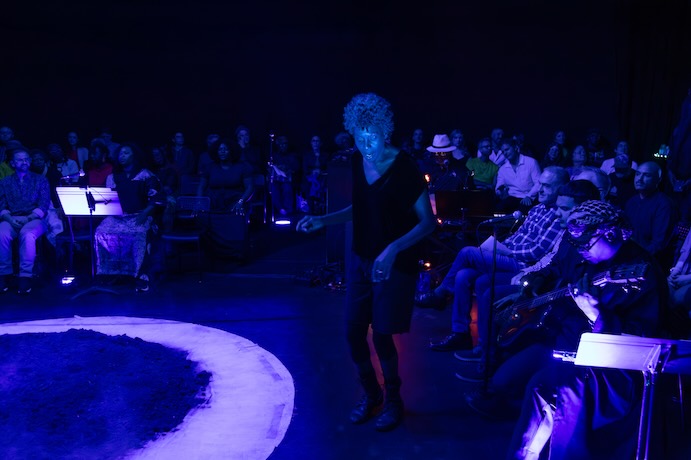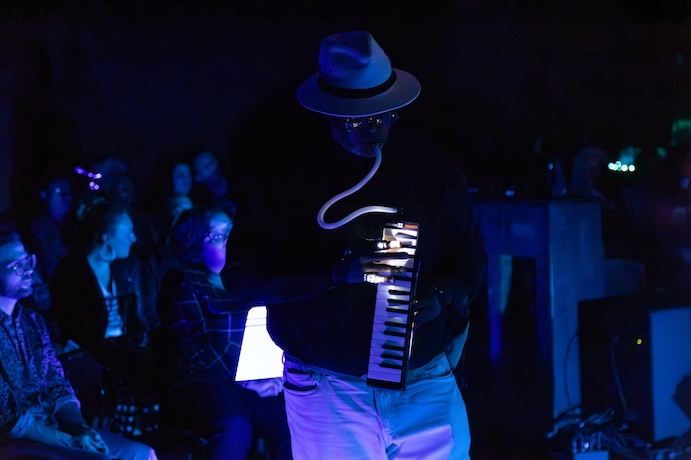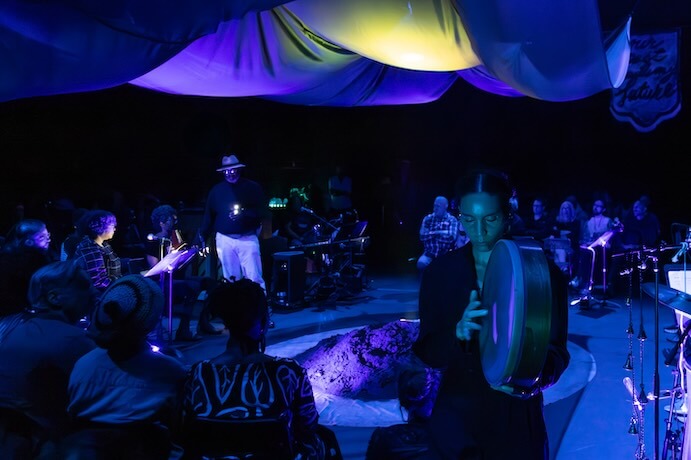The morning before I saw We Have Gone As Far As We Can Together, a ritual opera inspired by “the sonic and spiritual resonance of Alice Coltrane and Sun Ra,” I found myself having a conversation with a composer. He admitted something to me that he never tells anyone: he doesn’t like opera. I was neither surprised to hear this, nor put off by the idea of questioning age-old ideas of what opera is, or has to be.
But later that evening at the ritual opera’s Nov. 1 opening night performance, Philadelphia’s FringeArts venue was transformed into a terrain of wonder. The black box theater first opened to a curtained section with Cauleen Smith’s elaborate and massive banners with different maxims: “We Begin in the Dark and Death is the Birth of Life;” “Your past made my future possible.”
The 90-minute theatrical work was created in collaboration by Smith, multidisciplinary artist Helga Davis, director Charlotte Brathwaite, and dramaturg Sunder Ganglani, but they weren’t spotlighted in the program or the production. The opera is “rooted in a collective ritual ending,” exploring the “ways we put dead things to rest as a point of departure, while asking questions about the nature of individual and collective repair.” What was put to rest was a pedestaling of hierarchy, and one of the most defining characteristics of opera — the concept of diva.

At the door, I received instructions that I could sit or stand, sing, dance, walk around, change seats — “engage with this work in whatever ways you feel moved,” the program noted. I was skeptical it could work, that an audience could be entrusted to productively participate without causing mayhem.
As I wandered into the space trying to ascertain where the best seat might be, the opera had already started, in a sense. The audience encircled a mound of dirt in the center of the room. The darkened theater was awash in hues of blue, purple, and green, a sheer tapestry suspended in the air and spread across the audience. A mixture of humming, singing, Tarus Mateen’s flute, and a haze of synthesized meditative sounds wafted about the room; Anaïs Maviel slowly moved about dangling a string of bells.
“We are together to make peace, grief, and joy possible by communally letting go of old concepts or versions of ourselves,” the program said. The opera didn’t start – it happened, a defining feature of the experience: we didn’t just observe, we experienced. No announcement demarcated time; the texture of sound simply evolved.
The instrumentalists and choir began seated on the floor among us, which only came to light as some tapped their legs and softly clapped in rhythm while others remained in audience mode. A smoke machine joined the fray. A choir member, still not quite recognized as one, started to move with interpretive dance as Alexis Marcelo’s broken piano trills solidified into a rhythm, joining Jade Hicks on bass guitar and one lone voice that repeated, “We Begin.”

As the phrase grew (“We Begin in the Dark…”), the performers surrounded the mound of dirt, circling it in rhythmic steps punctuated by claps and sung chords that became metered, cornered, channeled — morphing from freely searching lines into a defined direction. Transitions between the six sections of the opera happened the same way each time: layers peeling off without warning, slyly replaced underneath with a different instrumentation or voice. “Opening” and “Invocation” shaded into “Connection to the Spirits” and “Planting a Seed/Funeral,” followed by “Transformation” and “Liberation.” The program was just as sly, stating “order subject to change.”
Though Helga Davis was billed as the lead performer, she mostly blended into the sea of bodies that were constantly moving around the dark theater. Without any one musician made into a focal point, it was impossible to see, let alone hear, where individual phrases and styles were going until after they had gone. Inflections ranged from atmospheric and avant garde to jazz, gospel, and rap. It should have been messy, crowded, confusing, disorienting, but each shift was engineered to hold continuity. Even as ideas decayed, the constant formation of new ones gave the sense of unbroken lines.
Participation was encouraged, but not haphazardly. The choir and instrumentalists gave specific instructions for performing five-note modal patterns, becoming conductors over their sections of audience. If one “conductor” misdirected a group, another would turn them to a different section to a spill of laughter.

The opera climaxed at its most communal after the audience had finally shed its trepidation to confidently participate. “Don’t you go knocking on doors that don’t want to be opened,” the choir sang in rounds with the audience. Sometimes, a non-pitched shout of “don’t go knocking on doors” mixed in; a friction between community and unity abounded.
But suddenly, Maviel sang out above the choir, pleading, “Open this door! Open this door please!” with an elongated spread of syllables. Light applause and laughter welcomed the line, and within moments, a mass of voices layered on a holler: “Open it up! Open them up for me!” A light shined out of a hole in the dirt while another pillar of light, smoke visibly rising within it, illuminated in one corner, and the tapestry suspended above the dirt and audience glowed green.
We Have Gone As Far As We Can Together is a triumphant reconceptualization of what opera feels and sounds like — enchanting, complex, and good. Attempts to invite audience participation, incorporate movement and dance, or introduce new stagings can often fall flat, but these elements all made the experience of this ritual opera more profound.
The composer I had spoken to earlier that morning said that if he had seen more possibilities for what opera could be in his music education, he might actually like it. He wants to like opera. We Have Gone As Far As We Can Together might be a great place to start – the ritual opera is a vision for the future of the genre and runs through Nov. 9.
I CARE IF YOU LISTEN is an editorially-independent program of the American Composers Forum, and is made possible thanks to generous donor and institutional support. Opinions expressed are solely those of the author and may not represent the views of ICIYL or ACF.
You can support the work of ICIYL with a tax-deductible gift to ACF. For more on ACF, visit composersforum.org.
























